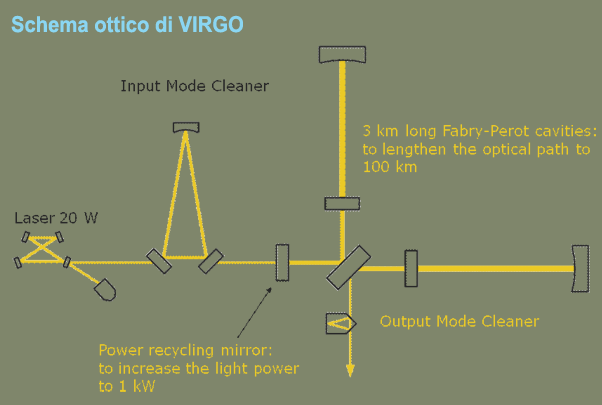
| HOME | NAPOLI GROUP MEMBERS | VIRGO | LISA | GRADUATION AND PHD THESES AND GW | CONTACT |

VIRGO AND THE GROUND BASED GW INTERFEROMETRIC DETECTOR

Interferometric wave detection was originally proposed by R. Weiss. In his paper he described a modified Michelson interferometer, using freely suspended test masses at
the ends of the arms. This is the technique used by all the
present-day GW observatories around the World. The idea is
that,being the GW radiation quadrupolar, when it impinges on a
Michelson interferometer with the proper polarization, one arm is
stretched, while the other is reduced. If L is the arm length, it
can be shown that the difference in length of the two arms due to a
GW of amplitude h is given by Δ L = 1/2 hL. Thus,to measure h =
10-21, with a kilometre-scale interferometer, a Δ L = 10-18
must be controlled.
A world-wide network of kilometre-scale interferometers is nowadays taking data. It is composed by the 3km armlength VIRGO interferometer in Cascina near Pisa, Italy, the two 4 km LIGO, in Hanford (WA, USA) and in Livingston (LA, USA), the 600m GEO600 near Hannover in Germany. Coincident data taking has already been run in 2007 2010 and 2011, and the LIGO Scientific Community (LSC) and VIRGO signed a MoU to exchange data in such a way that the four interfeometers can be considered as an unique observatory. To these interferometers the 300m Japanese TAMA300 interferometer can be also added.
The optical scheme of the VIRGO interferometer is shown in fig. 1. Final mirrors as well as the beam splitter and other optics are mounted on controlled active pendular suspensions in order to cut away as much as seismic noise is possible. Each arm consists of a Fabry-Perot cavity where light is reflected back and forth several times before escaping thus enhancing the effective arm length (by a factor called finesse depending on mirrors' reflectivity).
A recycling mirror re-inject in the interferometer the power reflected back to the input. A similar design with higher finesse cavities and less performant suspensions is adopted by LIGO interferometers .
| Laboratorio Onde Gravitazionali c/o Dipartimento Scienze Fisiche Universita' di Napoli Federico II Via Cinthia Complesso Universitario di Monte S.Angelo |